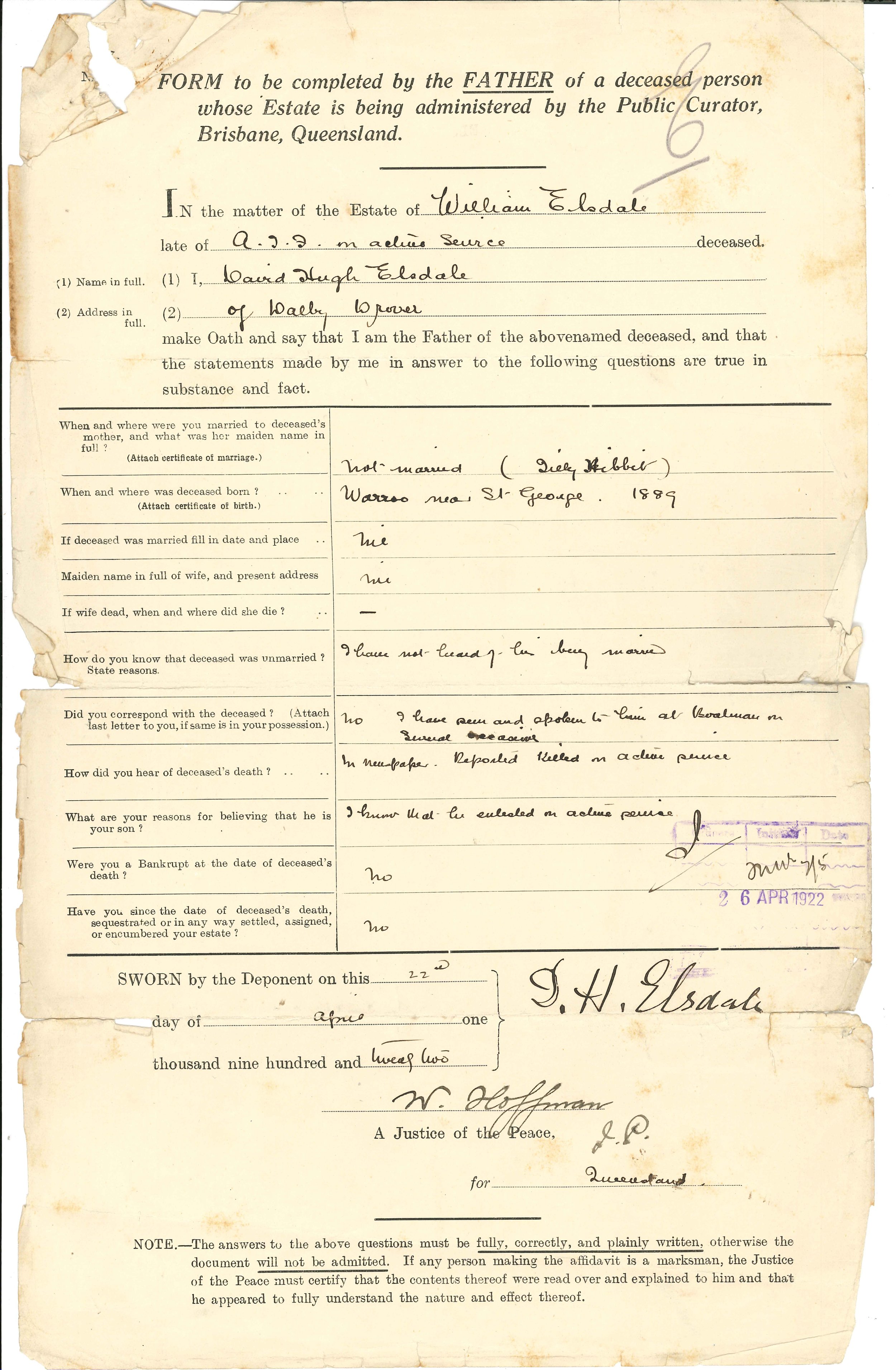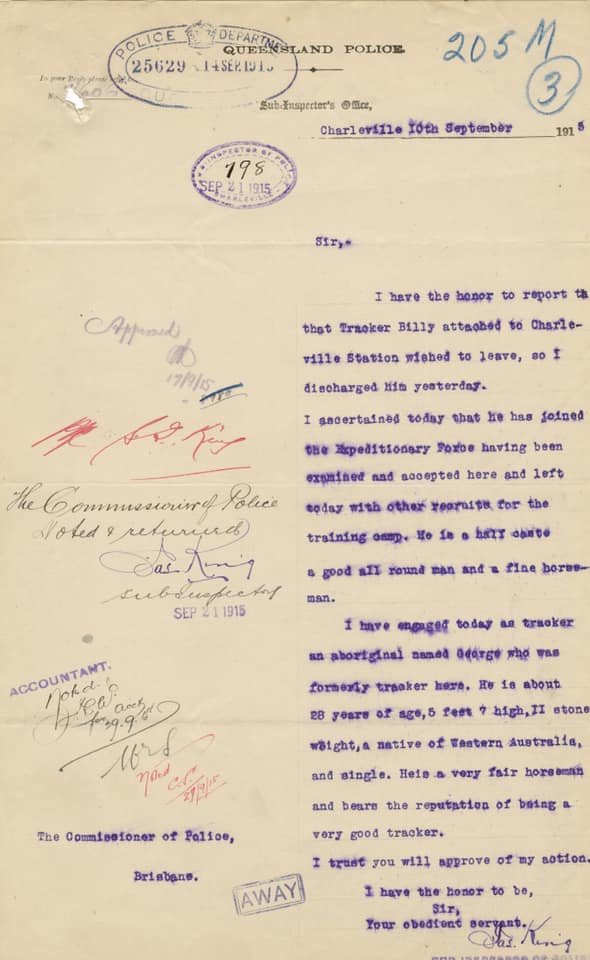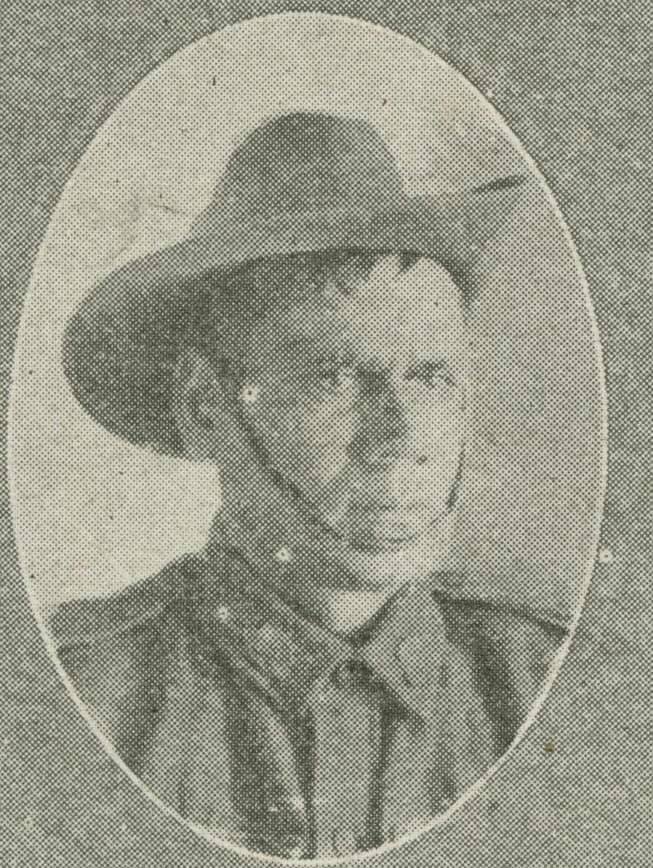Billy Elsdale, Queensland Police Indigenous Tracker and Anzac
This website contains names and images of deceased Aboriginal and Torres Strait Islander peoples.
Between 1914 and 1918, over 1000 Indigenous Australians enlisted with the Australian Imperial Forces, one of them was a police tracker from Queensland.
Today is the National Police Remembrance Day. Each year, on September 29, vigils, services and marches are held nationally to commemorate National Police Remembrance Day to remember and honour all police officers who have been killed in the line of duty, and also remember and honour officers whose death did not occur as a consequence of their duty. Last month, August 2023, the Queensland Police Museum applied for the name of Billy Esldale to be added to the Queensland Police Honour Roll, based on this research.
This extended biography is one of the series I have researched for my QP ANZACs project. The compendium containing all of the names and biographical details of Queensland Policemen who enlisted will be available next year. I am very grateful for research assistance of Lisa Jones, Curator of the Queensland Police Museum and Tim Lycett, a former Victorian police officer and an experienced military genealogist.
Private William Elsdale/ Ellsdale/ Elisdale (1886-1916)
Billy Elsdale was the only Queensland Police tracker to volunteer in the First World War, he is also ‘believed to be the first Aboriginal digger to die during action in France.’
William ‘Billy’ Elsdale was born David Elsdale, also David Hibbit, on 23 December 1886 in Warra, Dalby, Queensland (his birth was registered on 18 February 1887, which likely led to Billy giving his birth year as 1887 in later documentation). , His birth certification indicates that his parents were not married. Billy’s mother, Matilda ‘Tilly’ Hibbit/ Hibbitt (transcribed as Lilly), was Aboriginal. All evidence indicates she was related to the Aboriginal people with the surname Hibbit (or variations of), local to the area. She was born in 1864-65, to Catherine Orchard and Richard Hibbitt in Currawildi, Belmont/ Balonne Shire/ Maranoa, Queensland (cited differently across Tilly’s vital records).
Billy’s military service file described him as six feet and half an inch tall (184cm), 161 pounds (73kg), measuring 39 and a half inches (1m) circumference across the chest with brown eyes and black hair, complexion - ‘half-cast’[sic] and his religion is listed as Roman Catholic. He signed his application with a cross, which indicates he could not write. Billy was one of the first few Aboriginal Australians to enlist with the Australian Imperial Forces, after the World War I was declared on 28 June 1914.
Billy’s father was David Hugh Elsdale (10 May 1860 – 15 April 1938, Dalby) born in Warra, Queensland to British parents, who arrived in the Australian colonies from the United Kingdom. David’s mother, Anne Laird, was born in Belfast in 1826, and she arrived in New South Wales on the James Moran on 6 October 1841. Per the passenger list, Anne was a nursemaid, a Roman Catholic, and could read. David’s father, Alexander Hugh Elsdale, was born in 1818 in Lancaster, Lancashire. At 20 years of age, he was convicted of larceny (stealing a watch) at the Lancaster Quarter Sessions and sentenced to be transported for 10 years to New South Wales. Prior to his transportation, Alexander was detained in a prison hulk (a decommissioned ship used as a floating prison). According to the gaoler’s notes in Prison Hulk Registers and Letter Books, 1802-1849, he was single, literate (could both read and write), a weaver with a previous conviction, and a ‘very bad character’ as well as an ‘indifferent character’. Having spent three months on the convict hulk, he departed England on 27 July 1838 on the Earl Grey along with another 289 convicts, arriving to New South Wales on 21 November 1838.
In June 1843, Alexander was granted a ticket of leave, allowing him to stay in the district of Scone, NSW. Billy’s grandfather went on to have a life that was not unusual for an ex-convict at the time, a life that (ironically) saw a man end up on both sides of law enforcement. On 2 January 1853, Alexander H Elsdale was awarded £2 from the Police Reward Fund Account, for ‘activity and zeal in the apprehension of three prisoners who escaped from the watch-house Bargo’ – he was an officer with the local police force. However, in 1855 he was charged with stealing from a dwelling house – but subsequently found not guilty. Then, on 7 April 1857, Alexander was dismissed from the Goulburn Police Force for neglect of duty. Alexander Elsdale died on 21 March 1865 in Queensland, just before his son, David Hugh, Billy’s father, turned 5.
From 1913, until enlisting with the AIF on 10 September 1915, Billy worked as a police tracker at the Charleville Station, Queensland Police Force. Police trackers were not sworn officers and did not have legal authority. The roles police trackers performed differed from the Native Mounted Police paramilitary squads, in that the trackers worked alone or in pairs, and relied on their knowledge of the country to locate missing persons or recover property. In Queensland, the Native Mounted Police were disbanded at the turn of the twentieth century nearly a decade earlier, after operating from 1849 until 1904.
Billy is mentioned in the Charleville file correspondence, where he is described as ‘a good all around man and a fine horseman’. Notably, the police and military records, resignation from the force and enlistment with the AIF in Brisbane, are both dated 10 September 1915. Out of nearly 200 men who left the Queensland Police Force to serve in the AIF, Billy was the only Aboriginal man.
John Maynard’s study of the First World War records published in Joan Beaumont and Alison Cadzow’s Serving Our Country: Indigenous Australians, War, Defence, and Citizenship reveals that the greatest numbers of Aboriginal men signed up in the years 1914 to 1916; ‘[o]f the 989 records of Aboriginal men examined, 641 of them had enlisted before 1917. However, it is important to note that in contrast to other states, there was a spike in Queensland enlistment in 1917. In May 1917, under the pressures of the war, the military regulations were altered to allow the enlistment of ‘half-castes’ provided that ‘one of the parents is white and of European origin’. Before 1917, it was left to the medical officer to decide on the suitability of the candidate.
In 1901, the Australian Constitution declared all Australians, including Indigenous people, to be British subjects. In spite of this overarching status, in practice the rights afforded to Indigenous people were negotiated through legislative arrangements between various states and the Commonwealth. The colonial (later state) governments adopted numerous and conflicting definitions of ‘Aboriginality’, sometimes excluding ‘half-caste’ people from specific provisions and at other times including them. Blood-quantum distinction - an individual’s racial category - was viewed as being based on their genealogy, so a ‘half-caste’ Aboriginal person was also categorised as European.
Private Billy Elsdale, who’s ‘complexion’ was described as ‘half-cast’ [sic], was initially assigned to the 9th Infantry Battalion. He embarked on the HMAT Wandilla in Brisbane on 31 January 1916. On 3 March 1916, Elsdale arrived in Alexandria, Egypt, and soon after on 23 April 1916, he was transferred to the newly formed 47th Battalion, in Serapeum. On 2 June, the unit sailed on the SS Caledonia to France joining the British Expeditionary Forces. Arriving in Marseilles on 9 June, the battalion was later stationed at Outtersteen, near the Belgian border. On 7 July 1916, or just four weeks later, Billy Elsdale was killed in action during operations at Fleurbaix; he is interred at the Rue-David Military Cemetery, Fleurbaix along with 87 other Australian servicemen.
In Battle Scarred, Craig Deayton describes conditions the 47th Battallion faced, where the trenches were ‘not dug into the ground due to the high-water table, but ‘were instead raised sandbag breastworks.’ He writes:
Over time, enemy artillery fire had caused gaps in the breastworks and their snipers concentrated on these gaps waiting for passing soldiers who weren’t taking enough care to conceal themselves. Elsdale was one of those and he was picked off by a sniper while passing one of these gaps. He was the first soldier of the 47th Battalion to be killed in action.
Australian War Memorial records indicate that the 47th Battalion was formed in Egypt on 24 February 1916 as part of the ‘doubling’ of the AIF. Approximately half of its new recruits were Gallipoli veterans from the 15th Battalion, and the other half, fresh reinforcements from Australia. Reflecting the composition of the 15th, the new battalion was composed mostly of men recruited in Queensland and Tasmania. The new battalion was incorporated into the 12th Brigade of the Australian Division. Arriving in France on 9 June 1916, the 47th entered the trenches of the Western Front for the first time on 3 July.
Maynard recounts the battles and the men that succumbed to wounds and diseases in the trenches. He concludes, ‘these casualties indicate, Aboriginal men took part in some of the fiercest fighting on the Western Front, a theatre where the individual soldier was almost eclipsed by artillery and other weapons of industrialised war.’
Following Billy’s death, his personal belongings were released to Jack Cockrane, his designated next of kin: ‘disc, purse, 3 coins, aluminium ring, crucifix, photo, military certificates.’ The to and fro in the departmental correspondence reveals that Jack was also an Aboriginal man and had been employed by Cobb and Co for 25 years. Jack was ‘located through press’ as earlier attempts to find him were unsuccessful, this in part could be because he was illiterate. Billy’s parents are not featured in the departmental correspondence until 1923, when his father David Hugh Elsdale responded in writing to the department’s request to receive Billy’s war medals (Victory Medal and the British War Medal).
(An extended version of this entry will appear in the State Library Queensland blog as well as the publication)
References:
W. Ellisdale 4th Grenadier school, one of the soldiers photographed in The Queenslander Pictorial, supplement to The Queenslander, 1916, p. 27. SLQ Image number: 702692-19160624-s0027-0010
Digital copy available at: http://hdl.handle.net/10462/deriv/353398
“X” – The Life and Death of a Courageous Digger, Queensland State Archives, 1 Jul 2016. https://blogs.archives.qld.gov.au/2016/07/01/x-the-life-and-death-of-an-indigenous-digger/
David Elsdale, Birth Certificate, record no 850, Births in District of Balonne in the Colony of Queensland, 1887. 1887/C/85. The birth was registered on 18 February 1887, which likely led to Billy giving his birth year as 1887 in later documentation; David Elsdale, Birth Certificate OOOO85, p. 4388.
NAA B2455, Elsdale, B., First Australian Imperial Force Personnel Dossiers, 1914-1920, National Archives of Australia; Canberra; https://www.aif.adfa.edu.au/showPerson?pid=91350.
Public Curator form in Billy’s intestacy file, QSA Item ID 1413637; David Elsdale, Birth Certificate OOOO85, p. 4388.
Matilda Busiko died on 16 (17) Jan 1947 (married William Busiko, Reg 1891/C19) death registration 000769, p. 296, Mungallala, Maranoa Region, QLD.
Ibid.
“X” – The Life and Death of a Courageous Digger, QSA, 1 Jul 2016. https://blogs.archives.qld.gov.au/2016/07/01/x-the-life-and-death-of-an-indigenous-digger/
David Elsdale, Dalby Monumental Cemetery, Division: M, Section: Roman Catholic, Old, Plot: 3210. Memorial ID 210560907.
‘Anne Laird 1841 October James Moran’, Assisted Immigrant Passenger Lists, 1828-1896. New South Wales, Australia
UK, Prison Hulk Registers and Letter Books, 1802-1849 for Alexr Elsdale Justitia Register 1837-1844.
Microfilm Roll 90, Class and Piece Number HO11/11, Page Number 315 (159); https://convictrecords.com.au/convicts/elsdale/alexander/46158.
For more ex-convicts turn policemen see A Dukova, To Preserve and Protect: Policing Colonial Brisbane, UQP 2020.
Alexander H Elsdale, New South Wales, Australia, Returns of the Colony, 1822-1857.
Alexr. Hugh Elsdale Clerk of the Peace Registers, Registers of criminal cases tried at Goulburn, 1853-1859, New South Wales, Australia, Criminal Court Records, 1830-1945 .
‘District of Goulburn’, Reports of Crime, Etc for Police Information No 24, April 14, 1857, Police Gazette, New South Wales, Australia, p. 2.
“X” – The Life and Death of a Courageous Digger, QSA, 1 Jul 2016, https://blogs.archives.qld.gov.au/2016/07/01/x-the-life-and-death-of-an-indigenous-digger/
Please see Jonathan Richards, The Secret War: A True History of Queensland's Native Police, UQP 2008.
QP25629, Elsdale, QSA ID ITM317674.
The latest research places the number at over 1,000. https://history.cass.anu.edu.au/news/aboriginal-enlistment-during-world-war-i-month-history; https://indigenoushistories.com/2021/04/23/aboriginal-service-in-world-war-one-63-more-aif-volunteers-named/. Accessed on 4 Apr 2023.
Heather Burke & Lynley Wallis. The Queensland Native Mounted Police Research Database, Australian Research Council Discovery Project grant (DP160100307, The Archaeology of the Queensland Native Mounted Police)
https://frontierconflict.org/







